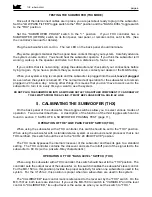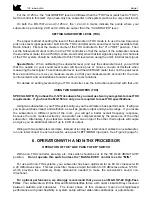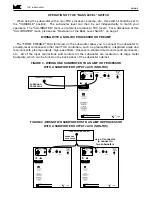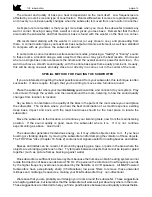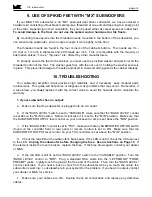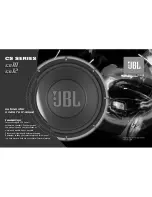
THX subwoofers
page 13
The amount and quality of bass you hear is dependent on the room itself. Low frequencies are
affected by a room's size and type of construction. Rooms differ when it comes to reproducing bass,
and in every room, bass quality changes when the subwoofer is moved from one location to another.
A simple rule to remember is that you get more bass when you move the subwoofer towards any
wall or corner. Moving it away from a wall or corner gives you less bass. Remember that the floor
also loads the subwoofer, and that maximum bass is found with the woofer on the floor in a corner.
We recommend starting with the woofer in a corner (or very close to one), and proceeding from
there. A corner location gives you maximum bass output and sonic excitement, as well as a standard
to compare with as you move the subwoofer around.
In some rooms, corner locations excite resonance modes, producing a "muddy" or "boomy" sound.
In these rooms, a location along a wall, away from the corner, may give the best results. Find a spot
where no single bass note overpowers the others and the overall sound is powerful and clean. You
want to achieve a smooth sound quality, with the entire bass spectrum equally prominent. Usually,
this will be along one wall, probably close to or directly in a corner, not in the center of the room.
SPECIAL METHOD FOR PLACING THE SUBWOOFER
If you are interested in getting the best possible sound from your subwoofer, this technique is often
successful. It does require, though, that you be willing to move some furniture around.
Place the subwoofer where your main listening position will be, and connect it to your system. Play
some music through the system, and then walk around the room, listening to how the sound quality
changes from location to location.
As you listen, concentrate on the quality of the bass in the parts of the room where you could place
the subwoofer. The location where you hear the best combination of a smooth response, exciting
deep bass, impact and sock, with the least boominess should be the best place to locate the
subwoofer.
Move the subwoofer to that location, and continue your listening tests, now from the main listening
position. If the sound quality is good, leave the subwoofer where it is. If it is not, continue
experimenting as above. Good luck!
The subwoofer generates tremendous energy, so it may vibrate objects close to it. If you hear
buzzing or vibrating objects, try moving the subwoofer and/or damping the vibration of those objects.
The THX "Wow" disc (Chapter 16, Side 2) contains test signals useful for locating buzzes and rattles.
Buzzes and rattles can be cured or improved by applying glue, tape, or pads in the area where the
objects are vibrating against each other. Try felt pads between objects that cannot be taped or glued
together (such as picture frames buzzing against walls).
One subwoofer is sufficient in a stereo system because the human ear-brain hearing system cannot
locate the direction of bass sounds below 150 Hz. We perceive the direction of low frequency sounds
by the higher frequency overtones reproduced by the Satellite or L/C/R speakers. All M&K Powered
Subwoofers have exceptionally sharp (36 dB/octave) low-pass filters to remove these unwanted
midbass and midrange frequencies, making your M&K subwoofer
truly non-directional.
We realize that you are probably won't design your room around the subwoofer. These suggestions
are helpful guidelines, but remember that the subwoofer will work well just about anywhere in the room.
These suggestions are intended to help you find a good balance between sound quality and aesthetics.
Summary of Contents for MX-150THX, V-125THX
Page 17: ...THX subwoofers page 17 ...






